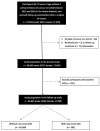Sex Difference in the Associations among Hyperuricemia with New-Onset Chronic Kidney Disease in a Large Taiwanese Population Follow-Up Study
- PMID: 36145212
- PMCID: PMC9501113
- DOI: 10.3390/nu14183832
Sex Difference in the Associations among Hyperuricemia with New-Onset Chronic Kidney Disease in a Large Taiwanese Population Follow-Up Study
Abstract
The global prevalence and incidence of chronic kidney disease (CKD) continue to increase. Whether hyperuricemia is an independent risk factor for renal progression and whether there are sex differences in the relationships between serum uric acid (UA) and a decline in renal function are unclear. Therefore, in this longitudinal study, we aimed to explore these relationships in a large cohort of around 27,000 Taiwanese participants in the Taiwan Biobank (TWB), and also to identify serum UA cutoff levels in men and women to predict new-onset CKD. A total of 26,942 participants with a median 4 years of complete follow-up data were enrolled from the TWB. We excluded those with CKD (estimated glomerular filtration rate <60 mL/min/1.73 m2) at baseline (n = 297), and the remaining 26,645 participants (males: 9356; females: 17,289) were analyzed. The participants who developed CKD during follow-up were defined as having incident new-onset CKD, and those with a serum UA level >7 mg/dL in males and >6 mg/dL in females were classified as having hyperuricemia. After multivariable analysis, hyperuricemia (odds ratio [OR], 2.541; 95% confidence interval [CI], 1.970−3.276; p < 0.001) was significantly associated with new-onset CKD. Furthermore, in the male participants (n = 9356), hyperuricemia (OR, 1.989; 95% CI, 1.440−2.747; p < 0.001), and quartile 4 of UA (vs. quartile 1; OR, 2.279; 95% CI, 1.464−3.547; p < 0.001) were significantly associated with new-onset CKD, while in the female participants (n = 17,289), hyperuricemia (OR, 3.813; 95% CI, 2.500−5.815; p < 0.001), quartile 3 of UA (vs. quartile 1; OR, 3.741; 95% CI, 1.250−11.915; p = 0.018), and quartile 4 of UA (vs. quartile 1; OR, 12.114; 95% CI, 14.278−34.305; p < 0.001) were significantly associated with new-onset CKD. There were significant interactions between hyperuricemia and sex (p = 0.024), and quartiles of serum UA and sex (p = 0.010) on new-onset CKD. Hyperuricemia was associated with new-onset CKD in the enrolled participants, and the interactions between hyperuricemia and sex were statistically significant. Hyperuricemia was more strongly associated with new-onset CKD in the women than in the men.
Keywords: Taiwan Biobank; follow-up; hyperuricemia; new-onset chronic kidney disease; sex difference.
Conflict of interest statement
The authors declare no conflict of interest.
Similar articles
-
Synergetic Association between Anemia and Hyperuricemia on New-Onset Chronic Kidney Disease in a Large Taiwanese Population Follow-Up Study.Int J Environ Res Public Health. 2023 Jan 12;20(2):1421. doi: 10.3390/ijerph20021421. Int J Environ Res Public Health. 2023. PMID: 36674173 Free PMC article.
-
Uric acid and incident chronic kidney disease in a large health check-up population in Taiwan.Nephrology (Carlton). 2011 Nov;16(8):767-76. doi: 10.1111/j.1440-1797.2011.01513.x. Nephrology (Carlton). 2011. PMID: 21854506
-
Uric acid and incident chronic kidney disease in dyslipidemic individuals.Curr Med Res Opin. 2018 Jul;34(7):1193-1199. doi: 10.1080/03007995.2017.1372157. Epub 2017 Sep 21. Curr Med Res Opin. 2018. PMID: 28836857
-
Serum Uric Acid and Progression of Kidney Disease: A Longitudinal Analysis and Mini-Review.PLoS One. 2017 Jan 20;12(1):e0170393. doi: 10.1371/journal.pone.0170393. eCollection 2017. PLoS One. 2017. PMID: 28107415 Free PMC article. Review.
-
Hyperuricemia and the progression of chronic kidney disease: is uric acid a marker or an independent risk factor?Adv Chronic Kidney Dis. 2012 Nov;19(6):386-91. doi: 10.1053/j.ackd.2012.05.004. Adv Chronic Kidney Dis. 2012. PMID: 23089273 Review.
Cited by
-
Gender Influence on XOR Activities and Related Pathologies: A Narrative Review.Antioxidants (Basel). 2024 Feb 7;13(2):211. doi: 10.3390/antiox13020211. Antioxidants (Basel). 2024. PMID: 38397809 Free PMC article. Review.
-
Elevated Uric Acid Levels with Early Chronic Kidney Disease as an Indicator of New-Onset Ischemic Heart Disease: A Cohort of Koreans without Diabetes.Biomedicines. 2023 Aug 7;11(8):2212. doi: 10.3390/biomedicines11082212. Biomedicines. 2023. PMID: 37626709 Free PMC article.
-
Serum uric acid is associated with chronic kidney disease in elderly Chinese patients with diabetes.Ren Fail. 2023 Dec;45(1):2238825. doi: 10.1080/0886022X.2023.2238825. Ren Fail. 2023. PMID: 37488934 Free PMC article.
-
The Bidirectional Relationship between Chronic Kidney Disease and Hyperuricemia: Evidence from a Population-Based Prospective Cohort Study.Int J Environ Res Public Health. 2023 Jan 18;20(3):1728. doi: 10.3390/ijerph20031728. Int J Environ Res Public Health. 2023. PMID: 36767097 Free PMC article.
-
Association between Consumption of Dietary Supplements and Chronic Kidney Disease Prevalence: Results of the Korean Nationwide Population-Based Survey.Nutrients. 2023 Feb 5;15(4):822. doi: 10.3390/nu15040822. Nutrients. 2023. PMID: 36839180 Free PMC article.
References
MeSH terms
Substances
Grants and funding
LinkOut - more resources
Full Text Sources
Medical


